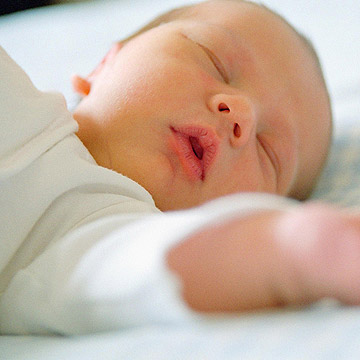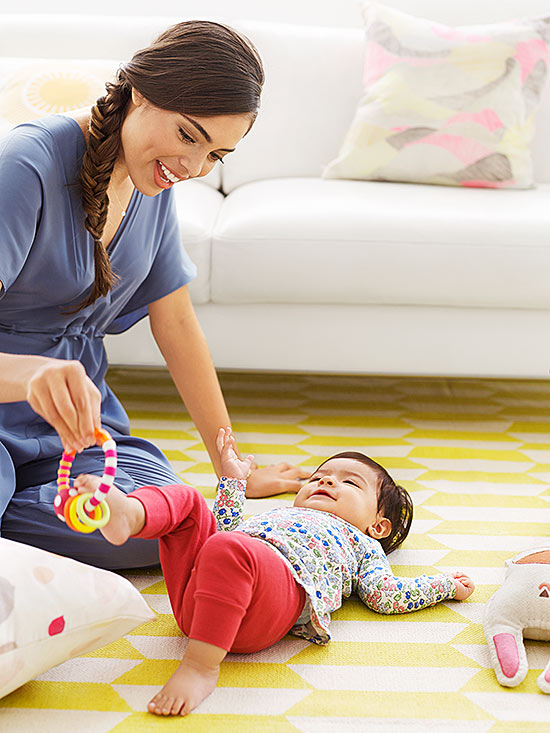
Little Bodies, Big Questions
Any first-time parents expect a silky-skinned and delicate-featured cherub at birth. Surprise! Plenty of babies are born with wrinkles, strangely hued skin, not to mention misshapen heads and puffy faces. You'll love yours regardless, but here's a realistic head-to-toe guide to prepare you for what to expect.
Baby\’s Head
What's normal: Meet your little conehead! Don't be alarmed if your newborn's skull has an elongated shape; it's made up of multiple soft, movable, bony plates that allow the head to be molded during labor so it can pass more smoothly through the birth canal. His oblong head will return to normal in one or two days.
But nature's work isn't complete. Your newborn has two areas on her head, known as soft spots or fontanels, where the bones haven't joined yet. The larger, diamond-shaped area on the crown persists until about 18 months, while a much smaller, triangular soft spot on the back of the head usually disappears between 2 and 6 months. The larger fontanel should be flat or slightly depressed when the baby is held upright. Because the brain is also protected by a thick, sturdy membrane, you can gently wash and comb the hair over this area.
Bruising and swelling of the scalp are common after vaginal deliveries, especially if forceps or vacuum extraction were necessary. (Baby's journey out of the womb isn't always without a little turbulence!) You may feel a soft, squishy swelling over the part of the head that emerged first or notice small abrasions from the fetal scalp monitor.
Although it is rare, the pressures of labor can also result in bleeding just above one of the skull's bones. This causes a well-defined lump to form over the back of one side — sometimes both — of the head after birth. This lump, known as a cephalohematoma, will go away but it may take weeks.
What's not: If the large soft spot is deeply sunken, dehydration, a typical result of vomiting or diarrhea, may be to blame, while a bulging fontanel may signal a serious illness, such as meningitis. Your pediatrician will measure baby's head during well visits to make sure it's not excessively large or growing too fast or slow.
Normal Eyes and Skin
Baby\’s Eyes
What's normal: You may see small, red hemorrhages on the whites of the eyes from tiny blood vessels rupturing during delivery. These red marks normally disappear within a few days. Plus, the eye medication doctors use at birth to prevent infection may irritate baby's eyes, causing some lid swelling or discharge that usually lasts only a day or two.
Newborns have weak vision; they can only see images clearly within 8 to 15 inches of their face. Because you're in clear view while your baby is feeding, use that time to bond by maintaining eye contact. And don't worry if he sometimes looks back at you cross-eyed, or if his eyes occasionally wander: Newborns may not always focus their eyes together.
What's not: Contact your pediatrician if you notice drainage that persists past two days or reappears shortly after being wiped away, excessive tearing, a cloudy cornea, a whitish pupil, an eyelid that droops or doesn't completely close, unequally sized pupils, or any persistent eye misalignment.

Baby\’s Skin
What's normal: Your baby's immature circulation can make her skin look mottled if she's cold, or make her hands and feet feel cool and appear bluish in the morning for the first day or two.
A yellowing of the skin, called jaundice, occurs in 60 percent of healthy newborns; it comes from bilirubin, a pigment made by red blood cells a newborn's immature liver can't effectively clear away. Jaundice typically peaks between 3 and 5 days after birth and resolves by 1 week of age. Sometimes treatment may be necessary.
What's not: A baby's face and lips may briefly turn blue during vigorous crying, but a persistent blueness of the skin, lips, or tongue, known as cyanosis, can be due to a heart abnormality, breathing problem, or other illness requiring immediate medical intervention.
While slight jaundice is harmless, very high levels of bilirubin may cause kernicterus, a type of brain damage that can result in cerebral palsy, hearing loss, and even death. Risk factors include being premature, being of East Asian or Mediterranean descent, having siblings who had severe jaundice, developing jaundice on the first day of life, bruising at birth, and not getting enough milk when nursing. High-risk babies are monitored carefully in the hospital and after discharge. Treatment can be provided to prevent kernicterus.
Normal Genitals and Umbilical Cord
Baby\’s Breasts and Genitals
What's Normal: At birth, the breasts of male and female babies can vary in size from tiny to nearly an inch in diameter, and the degree of enlargement can differ between breasts. This is due to pregnancy hormones and is harmless. The breasts shrink over the first few weeks of life.
Mom's declining pregnancy hormones may also cause a baby girl's labia to temporarily swell, or induce vaginal discharge or a few days of bleeding after birth. While a baby girl's swollen labia tend to resolve quickly, a disproportionately large scrotum on a boy might remain enlarged for weeks or months due to a small amount of fluid surrounding the testicles. If a baby boy was circumcised, the head of the penis may show signs of irritation and appear whitish or yellowish in places as it heals. His urine stream should be strong.
What's not: About 3 percent of full-term baby boys are born with one or both testicles not yet in the scrotum. That number increases to 30 percent for premature boys. Most undescended testicles will move into the scrotum in the early months of life. If they haven't dropped by 1 year of age, hormonal treatment or surgery can bring them down.
Baby\’s Umbilical Cord
What's Normal: The umbilical cord is white, translucent, and shiny when it's cut and clamped after birth. The remaining stump dries up and falls off usually between 1 and 3 weeks. In the hospital, physicians may apply a dye that dries the stump while inhibiting bacterial growth, or tell parents to swab the umbilical area with alcohol when diapering at home. Other doctors might suggest dry cord care: cleaning the umbilical area with soap and water whenever it's soiled and letting it air-dry. With either approach, sponge-bathe baby until the stump falls off.
What's Not: Signs of an infection include pus collecting at the base of the cord or redness, hardness, or tenderness of the skin around the stump; crying when the stump is touched (other than when cold alcohol is applied); or a delay in cord separation. A clear, urinelike discharge from the cord may indicate a structural abnormality of the umbilical area. Other than the occasional spot of blood on a diaper, the cord shouldn't actively bleed. After the stump falls off, a pinkish lump of scar tissue — known as an umbilical granuloma — that oozes a light yellowish material might develop. Call your doctor if you suspect an infection or spot any of the above irregularities.

Normal Feet, Weight, and Overall Health
Baby\’s Feet
What's Normal: Babies are tightly curled while in the uterus, so it's natural for a newborn's feet to turn inward from the toes. This should self-correct within a few months because baby is now kicking freely in the outside world.
What's Not: If the front part of a baby's foot is markedly curved inward and cannot be straightened with gentle pressure, then referral to a pediatric orthopedic surgeon may be necessary for treatment before she starts to walk.
Baby\’s Weight
You may wonder whether your baby is receiving the nourishment he needs. General guideline: Don't wait for him to cry to get the hint that he's hungry. Instead, look for early clues from your infant, such as bringing his hands to his mouth, waking up from sleep, flexing arms and legs, and moving his mouth or tongue. Here are two more clues that all is well.
Baby\’s Sick!
Call your pediatrician immediately if your infant is 2 months or younger and has a fever over 100.4? or another sign of illness, such as:
Congratulations! You've completed this crash course on understanding your newborn's body and should feel confident in identifying what is or isn't a natural part of your baby's physical development. That's not to say you still won't have occasional questions, but, at least, you now might consider removing your pediatrician's number from speed dial.
Marianne Neifert, MD, also known as Dr. Mom, is a clinical professor of pediatrics at the University of Colorado Health Sciences Center, in Denver, an author of four parenting books, a professional speaker, and a mother of five.
Originally published in American Baby magazine, November 2005.
All content here, including advice from doctors and other health professionals, should be considered as opinion only. Always seek the direct advice of your own doctor in connection with any questions or issues you may have regarding your own health or the health of others.
American Baby




